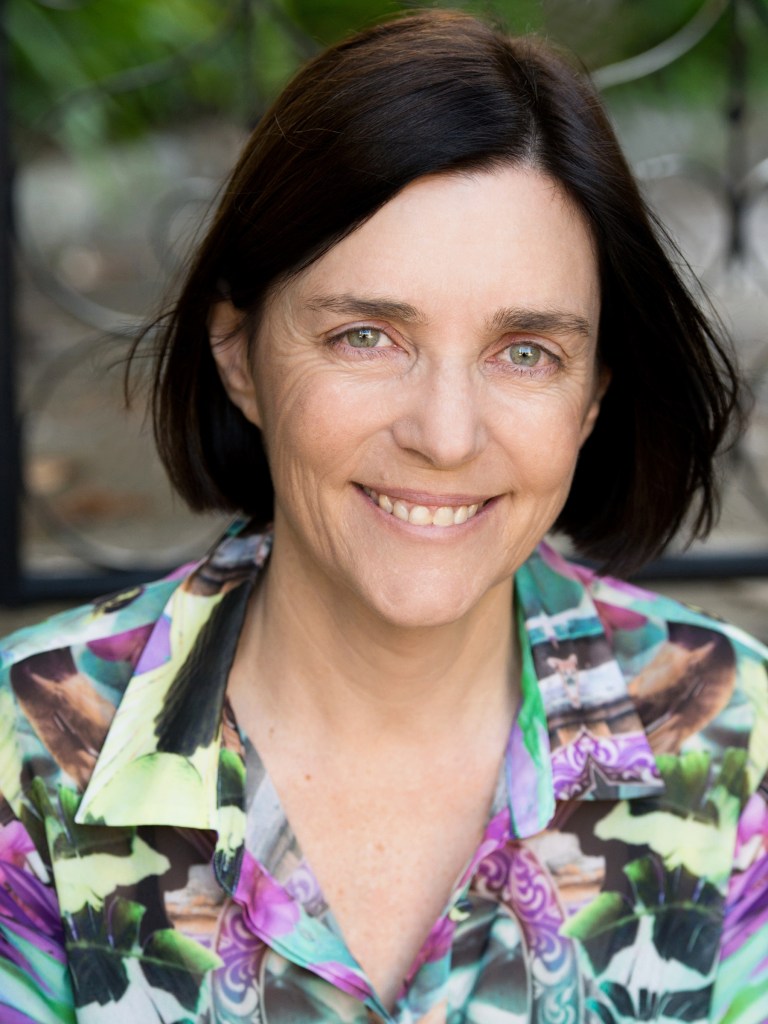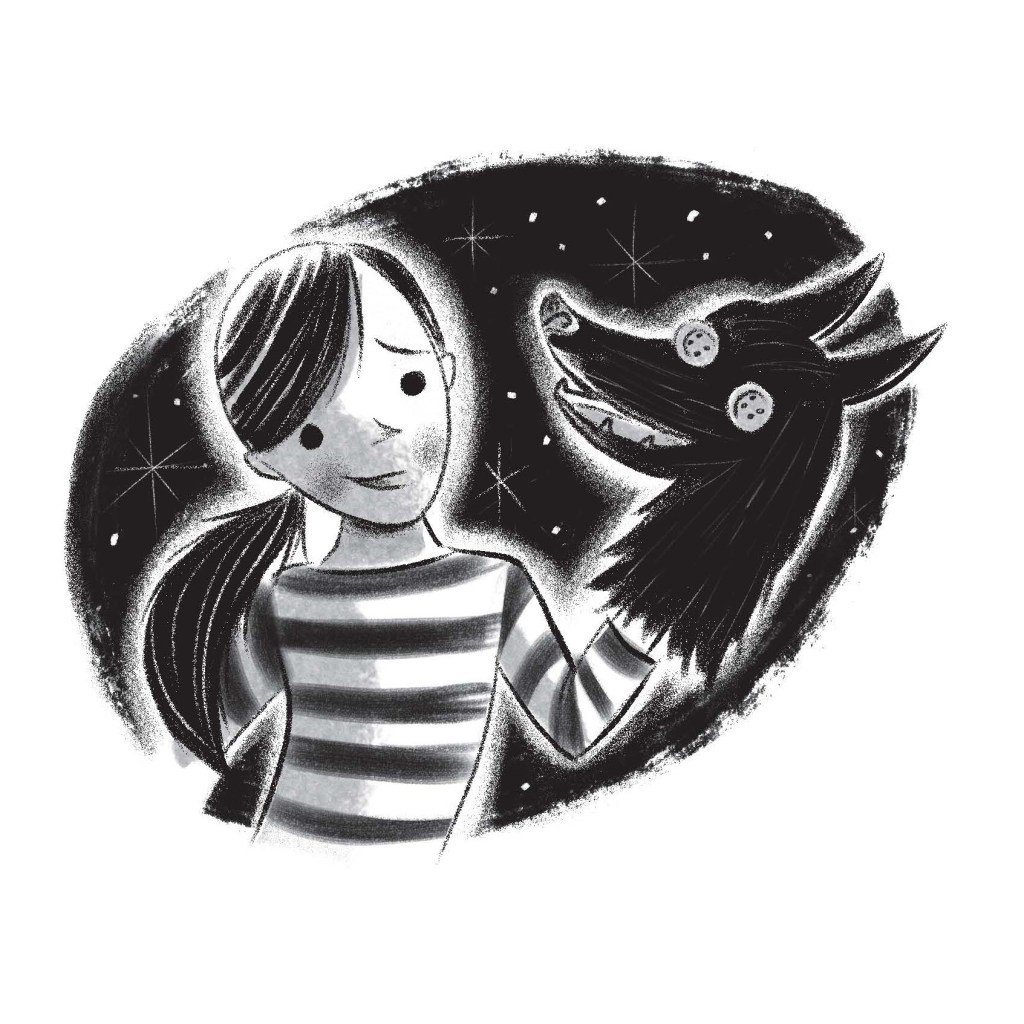Pierre’s Not There is full of wonder. It is a memorable and ground-breaking new story for 8-12-year-olds by Ursula Dubosarsky (published by Allen & Unwin). As well as being imaginative and relatable, it has a bold structure – the narrative becomes a puppet play.
When I heard about this book, I was desperate to read it. It exceeded my expectations.

I wrote the teacher notes on the book for the publisher, so here is my plot summary:
It is the school holidays and Lara is travelling with her mother to work. On the Sydney ferry, and whenever she feels the urge to hurry or experience more freedom, she notices a black dog. Across the water, the house her mother cleans has a tattered flag with a bear surrounded by stars. At first it seems that the house doesn’t want them to enter and a snarling clay figure in a pot plant in the hallway seems to reinforce this.
While waiting for her mother, Lara discovers a boy, Pierre, upstairs with his puppets and puppet theatre. He explains that his seven brothers and sisters and parents were eaten by a pack of wolves and he must go to his grandmother’s house across the river. He asks Lara to choose a puppet and join him in creating the story of his journey.
Once inside the puppet theatre, Lara magically becomes the puppet she has chosen. Its identity is unclear: it may be either a dog or a wolf. Lara and Pierre encounter other characters – Mr Punch, the Old Horse, Zady and the Bear-King – in their quest to find Pierre’s grandmother.
Satisfyingly, the tale employs a cyclic effect. It concludes by re-entering the ‘real world’, and once again a dog appears.
Teacher Notes Pierre’s Not There
Pierre’s Not There is thoughtfully and skilfully illustrated by Christopher Nielsen – a stunning new talent in book illustration and someone to watch. He not only rises to the challenge of the author’s innovative storytelling and structure, but heightens the atmosphere and drama.
Thank you for speaking to PaperbarkWords, Ursula.

Before we discuss Pierre’s Not There, you are the current Australian Children’s Laureate. Congratulations on this prestigious role.
What does it mean and involve? What is your specific aim? How would you sum up the experience so far?
Thank you – it was a wonderful surprise to be appointed and it’s been a terrific experience so far, although of course a little different to previous Laureates because of the restrictions of the Coronavirus. So, like all of us, less travelling in person and a lot more electronic talking and meeting! The purpose of the Laureate is to celebrate and promote children’s reading, so I chose as my goal for the two years to encourage as many children as possible to join their local library – actually get their own library card with their own name on it that they can use to borrow as many books as they like as often as they like. You learn to read at school, but it’s in libraries, libraries of all kinds, that children learn to LOVE to read. And if they love reading, they will read all their life long. That’s my Laureate motto – “READ FOR YOUR LIFE!”
Your book title, Pierre’s Not There, rolls off the tongue and is also intriguing. How do you hope to lure young readers with this title?
I’m not sure even where the phrase fell into my head. But once it was there I couldn’t get it out of my head, even though I didn’t know what it meant either! At one point I had thought of calling the book, very explicitly, “The Magic Puppet Show”, which is of course exactly what the book is about. But in the end both I and the publisher preferred the mystery and strangeness of my original title.
Why do you think your main characters Lara and Pierre are so appealing and beguiling?
I’m delighted that you find them so – character creation and character appeal are probably the hardest things to explain in writing. For me, the characters always feel like invisible friends, like real people. I talk to them in my head and they answer. It’s what’s inside them that interests me, their feelings, their fears, their laughter. I’m not good at picturing what my characters look like, but I know how they feel. Perhaps that brings something to them that draws the reader in.
How do you combine realism and surrealism so effectively and how do you create such an air of mystique?
Ah well, I think that’s just how I see the world! Life is one peculiar thing after another, isn’t it? and people are the most mysterious of all. In this book the use of the puppets is certainly something that creates that strangeness – are they puppets or real people? The surrealists were very attracted to puppets – and dolls and you can see why, at that halfway point between reality and the imagination. I think none of us feel quite comfortable when we enter a room full of puppets that seem to be looking right at us, even though we know perfectly well they are made of papier mache and cloth. But they seem to be full of their own secret life, which we can’t control.
Do you have a particular fascination with puppets? If so, what type of puppets or aspect of puppetry appeals?
I have always adored puppets since childhood, like most children. As a child I was taken to see the famous Australian marionette troupe “The Tintookies” as well as a wonderful shadow puppet theatre visiting from Indonesia which made a great impression. And there were terrific puppets on television – Bill and Ben, Mr Squiggle, Owly School. I preferred puppets to cartoons and to actual people on television for many years. The Muppets, which I adore, came later. I had a secret dream when I was 17 to go to New York and work on Sesame Street, but I had no idea how to make that dream a reality! As a child I made my own puppets and wrote plays and put on puppet shows for my family and we made puppets at school as well. Making your own puppet is a deep experience – you feel like Dr Frankenstein, that you are bringing something to life.
In the book I love the contrasting settings of a hot Sydney summer and the forest of the puppet play. Are there words or expressions that you use to create this marked difference? If so, could you give some examples?
What an interesting thing to point out. You’re right, of course, there is definitely a contrast in the hemispheres, between Lara’s experience of life in Australia and then the northern hemisphere, where Pierre comes from. And yes, the traditional puppet theatre, with its deep, sometimes dark European traditions of characters and scenery and folk tale are absolutely part of that. Pierre belongs to that tradition but Lara is a visitor in a sense, not sure if she really belongs to it or not. Perhaps the moment where she looks down into the depths of the fountain in the backyard, before she even meets Pierre:
“A blanket of humidity fell over her. The yellow grass crackled under her feet. She knelt down next to the fountain and peered into the pond. It was murky with weeds… She let the twig drop into the water and watched it sink slowly down, like a dying leaf.”
Could you share a clue or something that readers should watch out for while reading?
Well I think there is a constant uncertainty about Lara’s identity – is she a wolf or a dog, is she an enemy of Pierre or his friend? After all, his whole family was eaten up by wolves…. It is hard for both the children to know whether they can trust each other, even if they want to. In some ways the whole story is about trust.

What do you most appreciate about Christopher Nielsen’s illustrations?
Oh I love the beautiful palpable energy, the theatrical spontaneity, the humour, the drama, his use of light and shadow. I think they are also very wise illustrations – sometimes I felt he understood the story better than I did myself.

Which one particularly surprised you or struck a chord?
I love the one on page 102, where Lara’s wolf eyes light up like lamps. And I also love the one right at the very end, after the story is over, on page 195, where Lara is holding the wolf puppet in her hand.
Thanks very much for your responses, Ursula, and all the very best with Pierre’s Not There (I never know where you will take us next!) and your work as Laureate.
Pierre’s Not There at Allen & Unwin
Teacher Notes Pierre’s Not There

So good. Can’t wait to read.
LikeLiked by 1 person
You will enjoy this one Ruth!
LikeLike